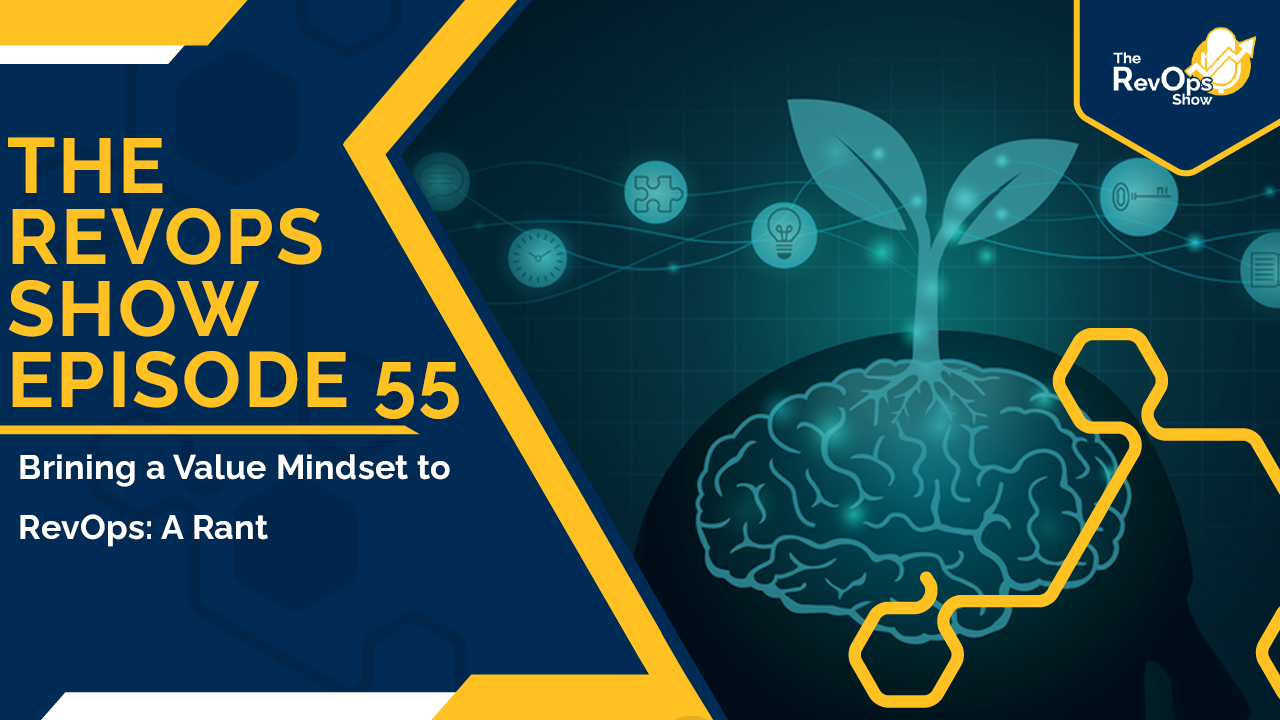Now that we’re getting up in the rankings for the show, Doug thinks he and Jess need a catch phrase. Maybe - Are you ready to RevOps? Or what about - We want you to RevOps! (We’ll work on it.) If you don’t watch the video, go over to the show notes and at least watch the impact Doug has while saying these catch phrases.
We’re going off the rails again in this episode with another topic by Doug who ended up naming the episode before it even began - Bringing a Value Mindset to RevOps: A Rant.
Audio:
Video:

Additional Resources:
[Book] Good to Great by Jim Collins
[RevOps Show] Get in to the Zone - The 3 Zones of Execution
Show Notes:
Doug is worried about RevOps. Why?
As RevOps is increasing, the nature of the RevOps role is increasingly falling into the very problem and cause of problem that the discipline is designed to solve.
What is the purpose of RevOps? What’s the underlying why of RevOps?
The underlying why of RevOps is better control of friction - reduce friction where it’s low value and manage friction where it’s of value.
It’s the counterbalance to the traditional go-to-market focus of “do more” to generate the flywheel effect.

The flywheel effect is:
- Attract
- Engage
- Delight
On the left side, we’re adding force to the flywheel by doing more. The other side we’re reducing friction so that you get more juice for the squeeze.

Keep in mind, a flywheel is more than just a circular reinforcing motion. A flywheel as it gets to a point of critical mass of velocity, it maintains that velocity. You can accelerate the velocity with less and less force. A flywheel has to have mass and velocity built into it so that it transfers energy efficiently.
Doug has seen a number of things that he thinks are going to destroy RevOps. One being a lot of jump on what’s next. Another that he’s seeing is people telling you what to do…”You need to do this.” He’s not seeing anyone talk about what you need to stop doing.
There’s a phrase that Doug researched by Peter MacArthur, “Every successful enterprise requires three people: a dreamer, a businessman, and a son of a bitch.”
Doug thinks people have a really misunderstood view of the son of a bitch, so Doug’s going to change that person to a skeptic. Doug doesn’t think you can have a real RevOps mindset without a healthy degree of skepticism. Gartner did research years ago that the typical company was spending on average $5,000 more per rep per year on technology. The result of that was a decrease of 12% on conversion.
A lot of what we’ve been talking about lately on the show has brought Doug back to the days as a financial advisor. If you didn’t know already, Doug worked for several years at Merrill Lynch as a certified financial planner. During that time what he discovered is that people who do the best are not the ones who figure out when to do something. They’re the ones who figure out when not to do something.
There are two schools of thought in the stock investing world:
- Growth Investor
- Value Investor
Growth investing is all about story and getting on the next thing. You’re counting on seeing the trend before everyone else does. This tends to be far more volatile. Value investing requires skepticism that borders on cynicism. Cynicism is harmful. A value investor is looking at companies and identifying where they are undervalued. A revenue operations mindset is all about less is more.
Connected to this is a story Doug tells about being at a conference. The speaker to one of the presentations began his presentation with - growth investors are jellyfish. Jellyfish have no backbone. They can only go where the tide takes them, and their destiny is to end up on the beach, dried out, and dead. He continued on to say that value investing and to be a value investor, you have to be a son of a bitch.
Turning this back to RevOps, if we think about all this hype that’s out there, the role of revenue operations is to get more juice for the squeeze. A revenue operations mindset is to say, hold on, let’s slow things down because we know anything new is disruptive.
If you think about the three zones of execution, the zone that RevOps owns is zone two - the enablement zone. It’s the operational zone. Doug isn’t saying that RevOps shouldn’t be excited about new things, but the problem is that RevOps is running up the hype cycle.

Doug would love to know for any RevOps people listening to this, how many of you have a tech stack smaller than you did when you started?
One thing that RevOps is supposed to address is the tech stack. What’s eating up the oxygen is RevOps saying more and more, you need to do this and you need to do this. One of the dangers of RevOps is that RevOps gone wrong becomes the department of growth prevention. There’s a balance between increased force and control friction. RevOps is supposed to be that balance. You have to have that mindset or you’re not going to deliver.
Do you know what the number one reason that businesses with strong growth potential never realize that growth?
They don’t make enough risky bets.
They don’t take enough risk.
Logically that makes sense, but if it’s wrong what do you do? You have to understand this is what RevOps is supposed to get. You have to control what you’re doing. When you’re off the rails, you have to slow the game down. BUT when you’re off the rails, it’s really hard to slow the game down. You have to start asking questions like:
- How do we play the cards that we have better?
- How do we play the resources that we have better to get the outcome that we want?
Right now Doug is seeing a lot of opposing things. If you’re a growth executive, if you’re looking at what’s needed, or if you don’t have that component, you’re missing something. What’s worse is if the discipline of your go-to-market isn’t bringing it, then you are going to be very confident. As you crash into a wall, are you going to be very excited or are you going to end up beached on shore, dried out, and dead?
Jess’s Takeaways:
- It’s good to have a little bit of skepticisim in RevOps - maybe even a lot of skepticism.
- It’s just as important to know when to do something and when not to do something. Internally we talk about this as slow is smooth and smooth is fast.
Next Steps:
-
Follow Jess, Doug & Imagine on socials for updates on the show or other insights:
-
Doug Davidoff: Twitter - @dougdavidoff | LinkedIn
-
Jess Cardenas: Twitter - @JessDCardenas | LinkedIn
-
Imagine Business Development: Twitter - @DemandCreator | LinkedIn
-
-
Subscribe to the show on Spotify & Apple Podcasts
-
Check out Let's Play RevOps on Twitch for more commentary on this topic
-
Listen to Episode 56: The Difference Between Red Work & Blue Work & Why RevOps Needs to Master Blue Work
